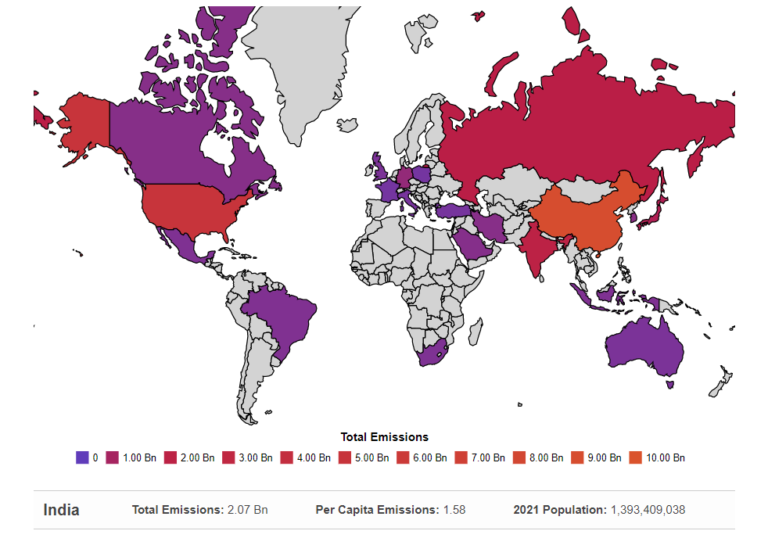A carbon footprint is the total greenhouse gas emissions (including carbon dioxide and methane) caused by an individual, community, event, organization, service, or product, expressed as a carbon dioxide equivalent.
A greenhouse gas (GHG) is a gas absorbs and emits thermal radiation, creating a “greenhouse effect.” Greenhouse gases are important in keeping the Earth a habitable temperature; however, excessive emissions caused by the increase in consumption are disrupting Earth’s carbon cycle and accelerating global warming.
We’ve highlighted the carbon footprint meaning and some definitions of other key terms we’ll cover in this post below.
Carbon footprint
A measure of the total amount of greenhouse gasses released into the atmosphere as a result of an individual’s, organisations, or nation’s actions. It’s usually measured in tonnes of CO2e (carbon dioxide equivalent).
Greenhouse gasses (GHG)
Any type of gas in the atmosphere that blocks heat from escaping. In relation to your carbon footprint and climate change, the main ones to mention are carbon dioxide, nitrous oxide, and methane.
The greenhouse effect
The process through which GHGs in the Earth’s atmosphere trap heat from the sun. Although this is a natural phenomenon that keeps the planet habitable, our GHG emissions are causing the Earth to warm up at an unnatural rate.
Climate change
A pattern of long-term change in the temperature and weather patterns either globally or regionally. Although these alterations occur naturally, man-made climate change is rapidly accelerating the pace of them.
Global warming
The rapid increase in average surface temperatures on Earth caused by the accumulation of greenhouse gases in the atmosphere. It is just one element of climate change.
Fossil fuels
Natural resources that produce carbon dioxide and other greenhouse gasses when burnt. Coal, oil and natural gas are all examples.
Carbon Footprint by Country 2021

Our rapidly growing carbon footprint is a problem of epic proportions. Most countries across the globe and their experts are discussing and analysing immediate actions that can reduce carbon emissions within the next 12 years.
Bhutan, on the other hand, is presently a carbon-negative country. Yes, Bhutan is a small country which lies sandwiched between two giants namely, India and China, and has zero carbon footprint.
So, How Does Bhutan carbon-negative country?
First, Bhutan is constitutionally obliged to maintain a forest cover of 60% at all times. The current coverage spans 72% of the country’s area. Second, they use renewable energy only produced through hydropower even though fossil fuel potential is present. Third, timber logging exports are banned and rural areas are provided with free electricity to combat dependence on firewood
Also, the Bhutan government doesn’t levy taxes on electric transportation vehicles. Besides, the government has initiated many future plans and targets to reduce greenhouse gas and waste production.

There are many ways in which we can make a difference, simple and practical adjustments in our current lifestyle can contribute to a better world. A shining example of this effort in our own backyard is the town of Meenangadi — the country’s first carbon-neutral destination. It is situated in the state of Kerala surrounded by the Western Ghats but was severely afflicted due to pollution and growing concerns over climate change as rampant mining and deforestation, health concerns and diminishing agricultural yield affected it. Today, Meenangadi is the model for zero-carbon development, nature conservation, and food and energy self-sufficiency.
We have seen two brilliant cases where a pint-sized country and a remote village in India have successfully reduced their carbon footprint, let’s look at the reasons behind this global problem.
We can minimise our carbon footprint and help the environment in many different ways. Whether at home, work, school, or while we travel, small changes can add up. In brief, to reduce your carbon footprint, we’ll want to do things like reduce the amount of energy we use, eat fewer animal products, shop locally, travel smart, and reduce our waste.
Reduce your carbon footprint at home
1) Insulate your home
Heating your living space can be an expensive and energy-intensive process. By insulating places like your loft and walls, you can make sure your home retains heat during the winter and stays cool in summer. It means you’ll use less energy, reducing your carbon footprint and your household bills.


2) Switch to renewables
Energy providers around the world are now offering greener tariffs. By switching to a company that provides electricity from solar, wind, or hydroelectric energy, you can reduce your household emissions and save money on your energy bills. You could even install solar panels if they’re readily available where you live.
3) Buy energy efficient
Electrical appliances are becoming more efficient by the year. What’s more, many countries now show how efficient particular products are, meaning you can make an informed choice. Whether it’s buying energy-saving light bulbs or choosing appliances with a high energy star rating, you can make your home more eco-friendly. Additionally, make sure to turn off and unplug anything you’re not using.


4) Use less water
It takes energy and resources to process and deliver water to our homes. What’s more, it’s also quite energy-intensive to heat it once it’s there. So, by using less, you can help the environment and lower your carbon footprint. Try turning off the taps when brushing your teeth, having short showers rather than baths, and only boiling the water you need.
5) Change your diet
The food we eat can have a significant impact on the environment. For example, meat and dairy products require a lot of land, water and energy to produce. They also create a lot of methane, a greenhouse gas. What’s more, food shipped from overseas uses a lot more resources than local produce.

Reduce your carbon footprint at work

Reducing emissions is something that you can do outside of the home too. Whether you make individual changes at work or company-wide policy adjustments, your activities can soon add up.
I. Turn off the lights
Powering empty rooms and office space is a huge energy drain. By making sure you turn off lights and appliances when they’re not in use, you can make sure you’re not wasting power. You could also request to install automatic, movement-sensing lights and energy-saving LED bulbs to address the issue.
II. Go digital
It’s never been easier to collaborate with others online. Whether through sharing documents using cloud storage or video conferencing instead of travelling, you can reduce your waste and emissions. Try moving away from printed documents where possible, and encourage others to work on their digital skills for the workplace.
III. Cycle to work
Cycling and walking are two of the most environmentally friendly ways to travel. And, not only are they good for the planet, but they’re also good for your health. If you can, choose to cycle or walk to work where possible. Your employer might even have a scheme that can help you purchase a bike.
IV. Reduce, Reuse, Recycle
Companies of all sizes use a host of different products in their day-to-day running. Whether its things like paper, electronic devices, packaging, or water, it all has a carbon footprint. By reducing the amount of waste you generate, reusing IT equipment, and recycling waste, you can make a real difference.
V. Eliminate single-use plastic
Single-use plastics may be convenient, yet they’re fairly dreadful for the environment. Not only do they pollute our waterways and oceans, but they also require energy to produce and recycle. You can stop using things like disposable coffee cups and cutlery to reduce your company’s carbon footprint.
VI. Switch off computers
The server with rows of idling computers takes up a lot of energy. You can reduce your work’s energy bills and carbon footprint by keeping electronic devices turned off and unplugged when they’re not in use.
VII. Use local food
This is a tip that can apply to just about every area of life. Locally-grown produce takes less energy to transport and supports the economy where you live. If you can get your work switch to local and sustainable food for the kitchen, you can help save the planet and help local businesses.
VIII. Take local trips
Sticking with the theme of your surrounding area, try and work towards field trips that are nearby. Instead of going to far-flung destinations that require planes, trains, or busses, stick to something close by. Your emissions will be far lower, and you’ll contribute to your community.
“Let’s nurture the nature so that we can have a better future.”










